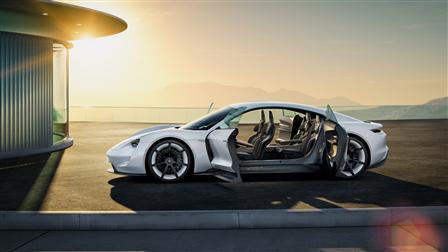Porsche Mission E is more than just the name of their first all-electric car; it’s the mission statement of what they hope to achieve with the vehicle. As Dr. Frank-Steffen Walliser, head of Porsche’s research and development explained: With Mission E, we are making a clear statement about the future of the brand. Read more: Porsche Tayacan 2022
An all-electric sports car with 600 hp:
zero to sixty in under 3.5 seconds, with a range over 500 kilometers (310 miles). This is Porsche’s vision for its first fully electric series production model and is scheduled to go into production by 2020. Our new electric sports car will be a true Porsche through and through, says Oliver Blume, Chairman of Porsche AG’s Executive Board. It will be a car that can be driven enthusiastically on every road by every driver. Like no other vehicle, it will feel entirely natural to drive.
Porsche Mission E fully electric vehicle:
At a press conference in Stuttgart on September 3, 2015, Porsche unveiled its first fully electric vehicle: The Porsche Mission E. With zero emissions and exceptional performance (0-60 mph in under 3.5 seconds), it’s sure to make quite an impact in its market segment. In his opening speech at the event, Porsche CEO Oliver Blume stated that they will bring a full-fledged Porsche product onto the market with exactly these features. While we don’t know how close it will be to production form, here are some photos and specs taken from their official press release. To learn more about developing electric vehicles, check out Clean Technica’s exclusive interview with CEO Stefan Niemand here.
A quick charging system charges the battery from 10% to 80% in 20 minutes:
It’s no secret that current electric cars aren’t exactly convenient. Charging a car can take hours, while refueling a gas-powered car takes minutes. Porsche is developing a quick charging system for its upcoming line of all-electric vehicles, dubbed Mission E, that will allow drivers to charge from 10% to 80% in as little as 20 minutes. This new battery system is still being tested and isn’t expected to hit roads until 2019 at the earliest. However, once it does arrive, drivers can expect to recharge their battery faster than they fill up at a gas station—thereby making electric cars more convenient and attractive options for consumers.
Porsche Mission E Range up to 310 miles:
Since its announcement at CES, Porsche has made clear that it intends to compete with Tesla’s flagship Model S in every way possible. Not only is range a crucial part of that equation, but charge time is too. By using two permanent magnet synchronous motors and an 800-volt electrical system, Porsche says its new sports car will be able to charge up to 80 percent in just 15 minutes—compared to 75 minutes for Tesla’s most powerful model. Electric vehicles have three main power ratings: range, charge time and maximum output. Some are more important than others, but all three are critical metrics when comparing vehicles like these head-to-head.
5 seconds from 0–60 mph, full acceleration at 5 seconds:
Porsche has just unveiled its newest car, and it’s unlike anything else you’ll see on a road near you. In fact, it’s unlike anything we’ve ever seen from Porsche. It’s called Mission E, and it’s not your average sedan. Two electric motors (PSMs) propel it forward with 520 horsepower, which is about what you’d expect from any number of sports cars—and those in the know say it accelerates from 0–60 mph in less than 5 seconds. But that acceleration doesn’t make much of an impression until you consider something else about Mission E: A battery pack that can be charged to 80 percent capacity in 15 minutes.
Comes with fast charging capability:
One charge enables a range of more than 500 kilometers (310 miles). This can be done in just 15 minutes at special charging stations. A technology that is currently being tested and will soon be put into series production by several carmakers. Porsche’s network will also have fast chargers, but they’ll also include additional functions: They are induction chargers that enable an emergency charging function for all e-vehicles, Porsche says. If you’ve got a dead battery, they’ll bring it back to life. That’s cool—but what else? What happens if there isn’t any power available? Porsche has a solution for that too: Generators mounted on all four wheels can turn kinetic energy from braking into electricity and feed it back into the battery.
Porsche’s first all-electric vehicle:
Porsche is on a roll with new technologies, and its latest innovation is nothing short of breathtaking. It’s called Mission E, and it’s Porsche’s first all-electric vehicle. Production models are expected to hit showrooms in 2022, but there are still plenty of details about the car that Porsche needs to finalize. Here’s what we know so far about one of automotive history’s most highly anticipated electric vehicles.
Due out by 2023:
It’s supposed to have a driving range of more than 300 miles, hit 0-60 mph in 3.5 seconds and recharge in 15 minutes. Like it’s gasoline-powered sibling, it’ll have front engine/rear-wheel drive with all-wheel drive as an option. With 800 horsepower, its top speed will be 155 mph (250 km/h). And its steering wheel will be equipped with touchscreen panels that display where other electric cars are on a map—so you can avoid running into them while you’re zipping around town. It could well be one of Porsche’s most important vehicles yet.

Leave a Reply